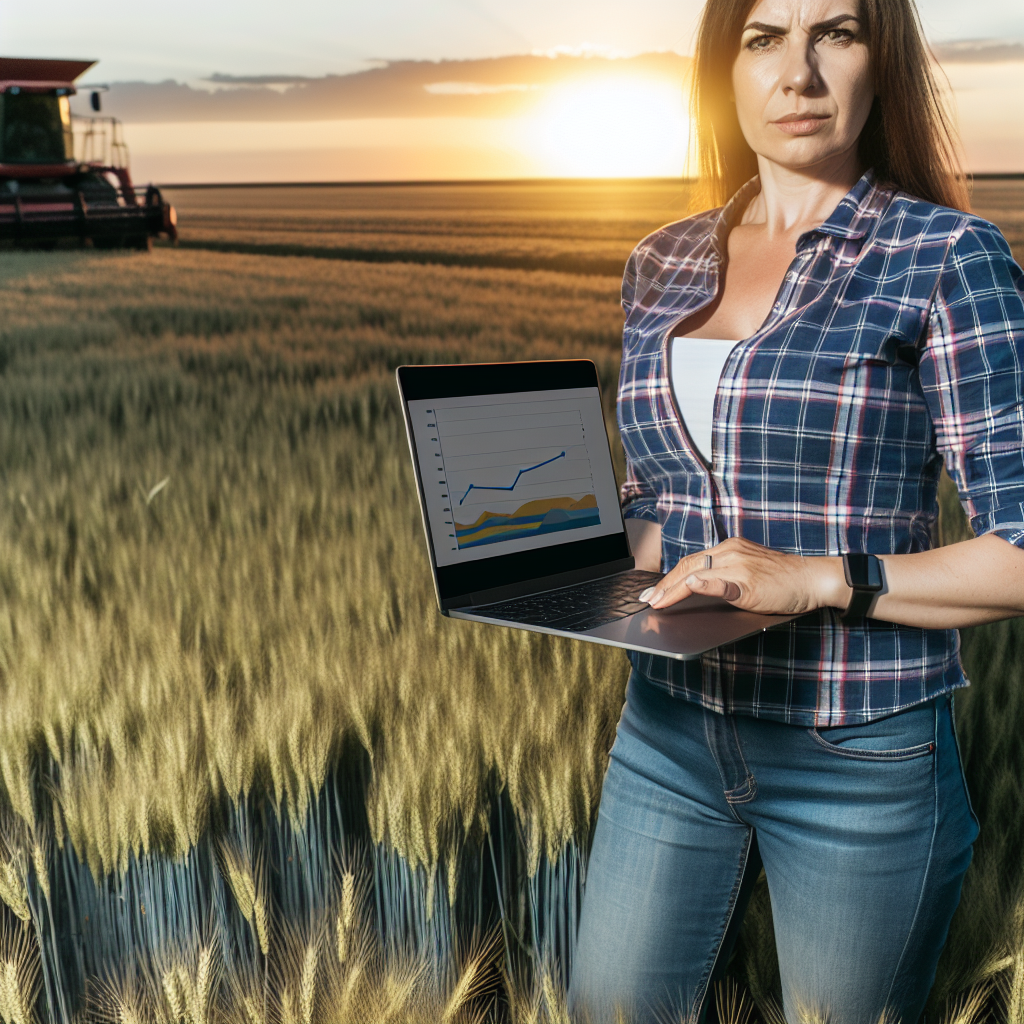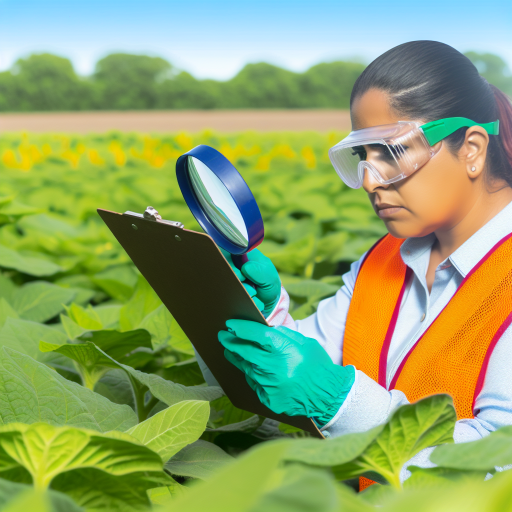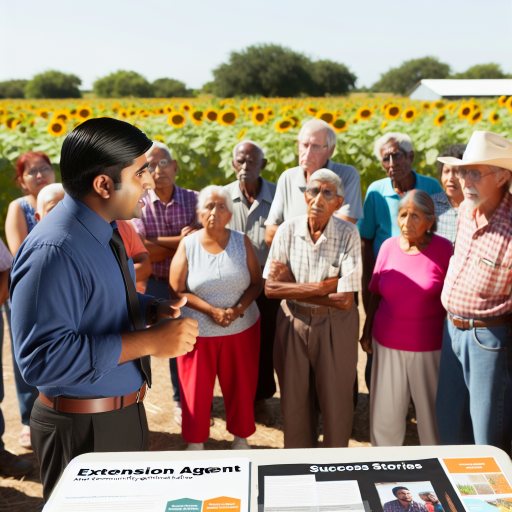Introduction:
Agricultural economists play a crucial role in crop forecasting.
They provide valuable insights for decision-makers in the agriculture industry.
Crop forecasting is essential for planning production, pricing, and trade strategies.
This post will discuss the significance of crop forecasting.
It will also address the role of agricultural economists in this process.
Finally, it examines the impact of accurate forecasts on the agriculture sector.
Definition of Crop Forecasting:
Crop forecasting is the science of predicting the yield and production of crops.
It is essential for farmers to plan their planting and harvesting activities effectively.
Crop forecasting is also crucial for policymakers in making decisions related to food security and trade policies.
Methods and Tools Used in Crop Forecasting:
One of the methods used in crop forecasting is statistical modeling based on historical data.
This method involves analyzing past yield data and trends to predict future crop production.
Another important tool in crop forecasting is satellite imagery.
Satellite imagery allows researchers to monitor crop health, growth, and overall conditions from space.
Weather data is also a key tool in crop forecasting.
Weather information such as rainfall, temperature, and humidity can help predict crop outcomes.
Remote sensing technology is another tool used in crop forecasting.
Remote sensing involves capturing and analyzing data from a distance using drones or aircraft.
Crop modeling software is widely used in crop forecasting.
These software programs simulate crop growth under different conditions to forecast yields accurately.
Machine learning algorithms are increasingly being used in crop forecasting.
Transform Your Career Today
Unlock a personalized career strategy that drives real results. Get tailored advice and a roadmap designed just for you.
Start NowThese algorithms analyze large data sets to identify patterns and make predictions about crop yields.
Crop forecasting also relies on ground-based surveys and field visits.
Field visits allow researchers to assess crop conditions firsthand and validate forecasted results.
Crop forecasting may also incorporate input from agronomists and agricultural economists.
Agronomists provide expertise on crop management practices, while agricultural economists analyze market trends and prices.
Overall, a combination of methods and tools is employed in crop forecasting to provide accurate and reliable predictions.
Role of Agricultural Economists in Crop Forecasting
Agricultural economists play a crucial role in providing valuable insights and predictions for the agricultural sector.
They collect and analyze vast amounts of data related to crop production, weather patterns, market demand, and other relevant factors.
Using statistical models and software, they process this data effectively.
Analyzing Data
Agricultural economists analyze historical data and current trends.
This analysis helps them identify patterns that assist in forecasting future crop production levels.
They can anticipate potential challenges or opportunities in the market.
Identifying Trends
By closely monitoring market conditions, agricultural economists evaluate supply and demand dynamics.
They assess factors such as prices and trade policies to understand market behavior.
Assessing Market Conditions
Based on their data analysis and trend identification, agricultural economists develop forecasting models.
These models predict crop yields for upcoming seasons, accounting for various variables.
Developing Forecasting Models
Once crop forecasts are ready, agricultural economists communicate their findings to stakeholders.
This information helps in making informed decisions regarding planting, harvesting, and marketing strategies.
Communicating Forecast Results
In addition to forecasting crop production, agricultural economists provide risk management strategies.
Showcase Your Business Today
Reach thousands of readers actively exploring professional services. Publish your business profile and grow your audience now.
Publish NowThese strategies help mitigate potential losses due to unforeseen events like adverse weather conditions.
Providing Risk Management Strategies
Agricultural economists support the development of agricultural policies at various levels.
Their insights inform policymakers about the current state of the agricultural sector.
Supporting Policy Development
They conduct ongoing research to enhance forecasting techniques and refine models.
This research incorporates new data sources to improve the accuracy of crop forecasting.
Conducting Research
Agricultural economists are essential in crop forecasting.
They analyze data, identify trends, assess market conditions, and develop forecasting models.
Their expertise helps in making informed decisions and planning for the future in agriculture.
Gain More Insights: Food Science and the Global Food Supply Chain
Impact on Agricultural Industries:
Accurate crop forecasting benefits agricultural industries by providing valuable insights into future harvests.
It helps in planning production schedules, ensuring optimal resource allocation and maximum yield.
Crop forecasting assists in developing effective marketing strategies, allowing farmers to target the right markets.
By predicting crop output, agricultural economists help in managing risks associated with fluctuating prices.
Timely and accurate forecasts enable farmers to make informed decisions regarding crop cultivation.
Agricultural industries can use forecasting data to negotiate better prices with buyers and suppliers.
Forecasting also aids in determining the need for storage facilities based on anticipated harvest volumes.
It allows for proactive measures to be taken in case of potential crop failure or weather-related challenges.
The information provided by agricultural economists enhances the overall efficiency and profitability of farming operations.
With precise forecasts, farmers can adjust planting schedules to meet market demands and maximize profits.
Find Out More: How Agricultural Policies Shape Rural Economies
Policy Implications:
Explore how crop forecasting data influences government policies and subsidies.
- Agricultural economists play a crucial role in providing accurate crop forecasts to policymakers.
- This data helps governments in determining the need for subsidies and support for farmers.
- By analyzing crop forecasting data, policymakers can make informed decisions on resource allocation.
- Government policies such as price controls and import/export regulations are influenced by crop forecasts.
- Subsidies for agricultural inputs like seeds, fertilizers, and machinery are based on predicted crop yields.
Discuss how policymakers use this information to make informed decisions about agricultural development.
- Crop forecasting data assists policymakers in planning for food security and market stability.
- Government investment in agricultural infrastructure is determined by forecasted crop production.
- Policymakers rely on this information to assess potential risks and vulnerabilities in the agricultural sector.
- By incorporating crop forecasts into policy decisions, governments can mitigate the impact of crop failures.
- Agricultural economists help policymakers in evaluating the effectiveness of existing agricultural programs.
Crop forecasting data provided by agricultural economists is essential for shaping government policies and subsidies for the agricultural sector.
By utilizing this information, policymakers can make informed decisions that facilitate sustainable agricultural development and ensure food security for the population.
Find Out More: Impact of Pesticides on Environment and Solutions
Challenges in Crop Forecasting:
Identifying the challenges faced by agricultural economists in accurately predicting crop yields.
Discussing factors such as weather uncertainties, technological limitations, and data inaccuracies.
Weather uncertainties pose a significant challenge for agricultural economists in accurately forecasting crop yields.
Unpredictable weather patterns, such as droughts, floods, and storms, can have a significant impact on crop production.
Technological limitations also hinder the accuracy of crop forecasting.
While advancements in technology have improved data collection and analysis, there are still limitations in terms of coverage and precision.
For example, satellite imagery can provide valuable information, but it may not capture small-scale variations in crop conditions.
Data inaccuracies further complicate crop forecasting efforts.
Incomplete or unreliable data can lead to inaccurate predictions, affecting farmers, policymakers, and other stakeholders.
Ensuring the quality and accuracy of data is crucial for reliable crop forecasting.
Another challenge is the complexity of agricultural systems.
Multiple factors, such as soil quality, pest infestations, and crop diseases, can influence crop yields.
Agricultural economists must consider all these variables to make accurate predictions, which can be a daunting task.
Additionally, market dynamics and trade policies can impact crop forecasting.
Fluctuations in prices, changes in demand, and trade agreements can all affect crop production and distribution.
Showcase Your Business Today
Reach thousands of readers actively exploring professional services. Publish your business profile and grow your audience now.
Publish NowAgricultural economists must factor in these external influences when forecasting crop yields.
Overall, the challenges in crop forecasting highlight the importance of continuous research, collaboration, and innovation.
By addressing these challenges and improving methodologies, agricultural economists can enhance the accuracy and reliability of crop forecasting.
This ultimately benefits farmers and the agricultural industry as a whole.
You Might Also Like: Agricultural Economists: Tools and Technologies Used

Future Trends in Crop Forecasting:
Advancements in technology play a crucial role in improving crop forecasting accuracy.
Big data analytics is revolutionizing crop forecasting by analyzing vast amounts of data.
Artificial intelligence is being utilized to develop predictive models for crop forecasting.
Machine learning algorithms are helping agricultural economists make more accurate crop yield predictions.
Remote sensing technology, such as drones and satellites, provide real-time data for crop monitoring.
Weather forecasting models are being integrated with crop forecasting tools for better accuracy.
Mobile apps and sensors are being used to collect data on soil conditions and crop health.
Precision agriculture techniques, like variable rate technology, help optimize crop yields and inputs.
Automated weather stations are being deployed in fields to gather precise weather data for forecasting.
Collaborative research efforts between agricultural economists and data scientists are driving innovations in crop forecasting.
Case Studies:
One successful initiative led by agricultural economists is the crop forecasting project in India.
Through this project, accurate predictions of monsoon patterns and crop yields are made.
These forecasts help farmers plan their planting and harvesting schedules effectively.
As a result, farmers are better prepared for uncertainties in weather conditions.
This proactive approach has led to increased crop productivity and reduced losses.
Another example is the crop forecasting model developed by researchers in the United States.
Using historical data and advanced analytical techniques, they accurately predict upcoming crop yields.
These forecasts enable farmers to make informed decisions regarding crop management practices.
By following these recommendations, farmers can maximize their yields and profits.
Ultimately, these initiatives have a significant impact on the agricultural industry as a whole.
Showcasing the Impact:
The accurate predictions provided by agricultural economists have transformed farming practices.
With timely information, farmers can mitigate risks and optimize their resources.
As a result, crop forecasting initiatives have contributed to increased agricultural productivity.
Farmers are now able to adopt modern techniques and technologies to improve efficiency.
Improved forecasting has also helped in stabilizing food prices and ensuring food security.
By minimizing crop losses, farmers can earn higher incomes and improve their livelihoods.
Furthermore, these initiatives have attracted investment and innovation in the agricultural sector.
Agricultural economists play a crucial role in driving sustainable growth and development in agriculture.
Overall, the accurate predictions have had a positive and lasting impact on farmers and the industry.
Agricultural Economists and Crop Forecasting
Agricultural economists play a pivotal role in crop forecasting.
They utilize economic principles and statistical data.
This role aids in predicting crop yields and market trends.
Furthermore, it helps mitigate risks for farmers.
Their analysis contributes to informed decision-making.
It supports crop planning and resource allocation in the agriculture sector.
Showcase Your Business Today
Reach thousands of readers actively exploring professional services. Publish your business profile and grow your audience now.
Publish NowAgricultural economists provide valuable insights for policymakers.
Stakeholders and investors also benefit from their work.
Accurate crop forecasting enhances food security.
It aids in stabilizing prices and boosting agricultural productivity.
Their research is vital for sustainable agricultural practices.
It fosters long-term growth within the sector.
The importance of agricultural economists in crop forecasting cannot be overstated.
They are essential to the success and efficiency of the agriculture industry.
Their work impacts not only farmers, but also consumers, markets, and the overall economy.
Additional Resources
Multi-Cropping Practices: Recent Trends in Double-Cropping
Climate Change Impacts on Agriculture and Food Supply | US EPA
[E-Books for Sale]
The Big Book of 500 High-Paying Jobs in America: Unlock Your Earning Potential
$19.99 • 500 High-Paying Jobs • 330 pages
Explore 500 high-paying jobs in America and learn how to boost your career, earn more, and achieve success!
See All 500 High-Paying Jobs of this E-Book
1001 Professions Without a Degree: High-Paying American Jobs You Can Start Now
$19.99 • 1001 Professions Without a Degree • 174 pages
Discover 1001 high-paying jobs without a degree! Unlock career tips, skills, and success strategies for just $19.99!




